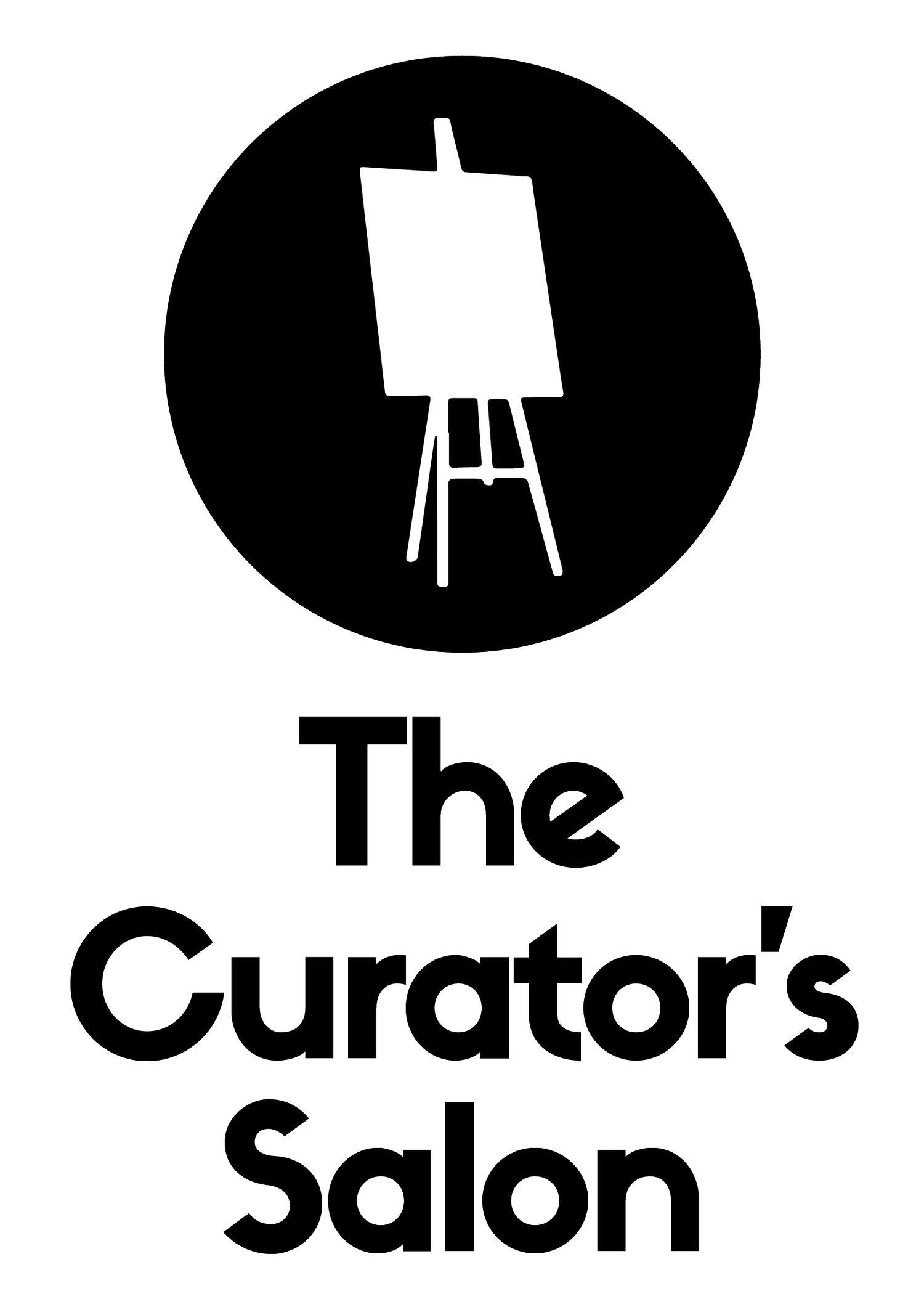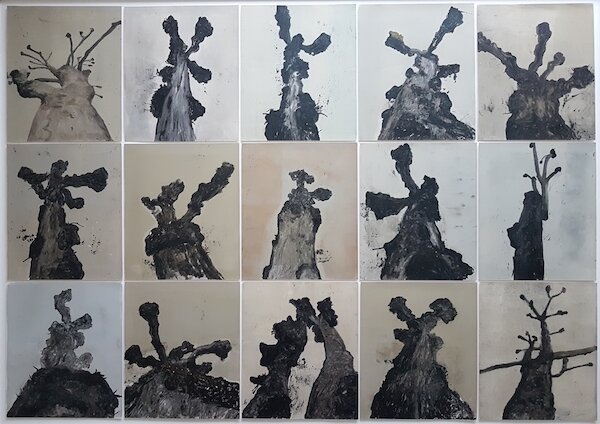Stewart Taylor
I enjoyed catching up with Devon-based printmaker Stewart Taylor who shares his passion for trees through gelli plate monoprinting and the dream projects that keep him motivated.
Share a bit about your background.
I drew fanatically from a very early age, but, like many, that initial wonder & passion waned somewhat under a stilted arts education at an academically-minded Grammar School. Nonetheless, I decided to take the leap into arts higher education (instead of one of the sciences, which was my other option...I hasten to add in which I got higher 'A' Level grades than art) with the blessing of my parents, who were both musicians and always hugely supportive of my creativity.
Stump #192 (Gallants Oak Ghost) by Stewart Taylor
My initial introduction to printmaking came very early in my foundation course at City & Guilds of London, in an etching class under Michael Fell.
I knew after that day that I was going to be a printmaker - the ability it gave to move drawing into an entirely different realm, particularly with regards to light and the metaphysical, had me hooked.
I was then hugely fortunate to have both resident & visiting fine art 'giants' as lecturers for my Degree at UCA Farnham - Pete Nevin (who remains a dear friend to this day), Peter Kennard, Jim Tierney, Timo Lehtonen & Sandy Sykes.
Combined with the print technicians (Carl & Jonathan), they gave me a very real direction towards a professional practise, which sustained me for years.
They would all do anything to get students to wake up and expand their thinking and awareness, and to be fully conscious as artists and to contextualise one's ideas with the medium.
I now live In Devon, after living and working all of my adult life in London (I was lucky to get redundancy last year, after working in media for 13 years to supplement my calling as an artist).
The journey towards moving here started when my partner bought several acres of land from her father in 2018 (which we are still decluttering of human detritus - it was previously used for market gardening in the last century by her Grandfather).
Stump 117 by Stewart Taylor
We will continue wilding this in the next few years; hopefully, in years to come, we will be able to expand our acreage & continue to give something back to nature.
What ideas are you exploring in your work?
I am continually interested in the self-inflicted demise mankind faces within our Anthropocene era, our behaviour within it, and its consequences. Although my overall outlook here is fearful and pessimistic, I try to create a contrary world of destruction, beauty & occasional fatalistic humour; where metaphysics, erasure, air & light, & relationships between things & humanity are all of critical importance.
These feel like they've had a natural evolution from the ideas of loss I first explored around the Death of my Father series for my Degree Show, where I employed site-specific photography (shared Places of significance) overlayed with His ephemera, motifs, and allegorical items; from then all of my Prints were made personally significant by Landscape I have experienced, whether it be London, Ireland, USA, Indonesia, Argentina, Spain, etc.
This shifted somewhat when I moved from photo-based silkscreen to work with monoprints, at first just making simple images around still life, objet trouve & landscape, purely as sketches, with sheer joy…
...But at the same time, these subjects were chosen carefully, & still laden with metaphor around Environmental loss, ecocide, and climate change, both imagined as stories, impending, and real. There are also some more Hopeful images I made too, one relating to an old apple tree on our Devon plot which we saved; another related to the amazing recovery of the Californian Condor from the 1980s onwards.
I then did several of the Pollarded Lime Trees outside my old London flat at the start of 2020, and then the whole street; and then all the surrounding streets andI quickly recognised that London’s street trees (predominantly Lime and Plane, chosen for their resilience to pollution) were something of a multi-valent representation of so many things we widely don’t know about ecology, through to nature’s real place in our world, and our place in It.
What is your artistic process?
For the last two years, I've been monoprinting using gelli plates, employing images taken on my camera phone, or on occasion working directly on to the gelli plate in situ (This is climate/weather dependent - I attempted to Print in Breckenridge/USA at 11,500 feet, but as there was 0% Humidity the Ink dried and cracked on the Plate the moment I rolled it out!).
With The Tree Portraits series I'm generally creating one layered blend on colour, predominantly to describe a setting sun/End of Epoch, over which I then lay a second Print of the stump/tree in question, drawn negatively into a rolled out, black/brown plate.
Making over 200 of these, I've discovered a certain rhythm to doing things in such volume, for the first time in my career, I think. I tried to represent every tree in my surrounding streets – the repetition of shapes, forms, movement & texture reminds me of a cruder form of Chinese Sung painting, where artists would spend years representing birds, flowers & landscapes thousands of times until the process takes over & that subject metamorphosises and almost becomes something else. This complements the metaphysics that printmaking automatically allows the artist.
Up Shit Creek by Stewart Taylor
I've been lucky to have the Wilding Project to help feed into this body of work - I've read countless books around the subject on ecology, trees, and subsequently fungi, particularly entangled life by Merlin Sheldrake, which brilliantly describes the almost total connectivity it has with trees, and all other living things. The last 20-30 tree portraits I've done have been influenced by these relationships, whereby I started using the ghost image from an original monoprint (the remaining ink/image on the plate.) and then printing over these using hand-cut stencils (around the original outline of the stump) with translucent white/creams.
The ink on this print would then behave/look like the fungal mycelia that reach throughout any given tree. I also enhanced these further, on occasion, by feathering edges with a large, dry paintbrush.
Can you talk a bit about the evolution of your practice and your work?
Before my gelli print phase I'd worked almost exclusively using photography, rather than from it, and pushing this through photoetching (whilst being a Keyholder at Artichoke in Brixton, after I was rejected by both the RAC & The Slade for their respective Masters Degrees), and then silkscreen from 2000 onwards.
I was fortunate to work as a silkscreen technician after I graduated (I did little/none at college!), which gave me the confidence to use this in my own practice when I became a Keyholder at East London Printmakers.
The silkscreen prints I did in that period - 2014-18 - amounted to a serious body of work, which was good enough to get me regular exposure at most of the UK Print Open Exhibitions/Fairs, a near sell out edition ("Fall'd Flabingo") at the RA Summer Show, & an award (Alcala - NOPE Great Art Prize).
Which artists or leaders do you look to for inspiration?
I did my graduate thesis on Philip Guston, who to this day remains a major touchstone, & was to my mind the greatest American Painter of the last Century.
His decision to move away from abstraction in the late 1960s to a personal and politically charged oeuvre caused huge controversy, & continues to do so to this day, long after he died in 1980.
He had a major retrospective lined up to start this year ("Philip Guston Now"), but the four museums concerned (NGA Washington, MoFA Houston, the Tate Modern, and MoFA, Boston.) postponed these for four years after considering the BLM protests in both countries.
Clumsily explaining that the work (specifically his '69-'70 Paintings & Drawings containing Klansmen) needed to be framed by “additional perspectives and voices.”.... this despite the exhibition catalogue already containing essays by 2 African American Artists.
Thanks to widespread outrage & petitions (including the hugely influential & Inclusive Brooklyn Rail) the Shows have been brought forward (Covid-pending!) to 2022, & needless to say I'll be returning to London to visit the Tate show.
Stump 190 by Stewart Taylor
As an extension of my love of Guston, I've included below a quote from the Minimalist Composer, John Cage, who visited Guston's Studio (they were both huge fans of each other's output) in the 1950s.
Although this related in essence to his Abstract Expressionist work of the time, I think it applies even more to his great, last decade, and indeed to most visual artist when they are working.
"When you are working, everybody is in your studio - the past, your friends, the art world, and above all your own ideas - all are there. But as you continue painting, they start leaving, one by one, and you are left completely alone...then, if you are lucky, even you leave."
Which THREE artists do you enjoy at the moment?
All of the following fellow printmakers work in what most would describe as being almost classical styles - but, for me, their, subject matter is underlined by man's seemingly constant need to dominate his environment.
Emily Allchurch - I first remember seeing her intricate digital prints c.6-7 years ago in an edition of Printmaking Today, & located an urgent need to try and equal her exquisite eye for detail in my Silkscreens at the time. I was delighted to exhibit alongside her in the RA Summer Show in 2019.
Sarah Gillespie - I loved her superb 'Moth' Mezzotint series last year at Eames Fine Art, & acquired a copy of the accompanying book the same day! we're now near neighbours in Devon and hope to meet at her Studio soon.
Bunny de Sade - Bunny was at East London Printmakers with me 10 years ago, & I've always loved her Bonsai etchings. she now resides in Thailand and has Upscaled her wickedly twisted Trees.
What is the most memorable thing someone has said about your work?
"This is one of the best Fine Art Print Degree submissions I've seen in nearly 20 years"
The Tree Portraits by Stewart Taylor
Following my Degree Show Private View, the aforementioned Jim Tierney left a note in my comments book, requesting if I could spare a few moments to talk to him about my Work.
This was duly arranged, & upon meeting him it was apparent he was deeply moved by my Show, particularly referencing the lyrical, quiet beauty.
He then described it as above. Needless to say, I was completely bowled over. It's hard to underestimate the positive effect words like this have on any artist, never mind one who's journey has barely started.
Sadly, Jim passed away a few years ago. He had quite a fearsome reputation, but it was very apparent from the outpourings of others at that time that my experience described here was more typical of who he really was.
Stump 150 by Stewart Taylor
What would be a dream project for you?
I've often wanted to engage in something that traverses the boundaries of Science & Art - it may seem through the amount of literature on Plants, Fungi, Ecology & Climate Change that I've ingested for the Tree Projects Series that I've already achieved that!
But what I feel now would be beneficial to my practice is to research a potential collaborative project that would sit in this arena.
I've yet to do something of scale with other artists/agencies; the energy and co-operative nature of something like this would be of real interest to me.
Follow Stewart on Instagram @StewartTaylorPrints.
Website https://stewarttaylorprints.com/






